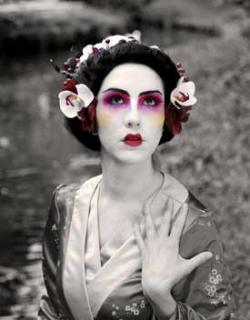A Midsummer Night’s Dream

Review by Susan Meehan
The Japan Society’s Contemporary Lifestyle Committee organised a special theatre evening on 19 February, for Society members to watch A Midsummer Night’s Dream followed by a Question and Answer session with the actors, director and technical crew – all inclusive at a bargain rate.
Noticeable on entering the intimate theatre was the Kabuki-inspired walkway, reminiscent of the hana-michi; the Noh-inspired pine tree or kagami-ita painted on the back of the stage and the actors clad in simple kimono. The Japanese influence on this production was no surprise given that the British Chinese director, Jonathan Man – of the Yellow Earth Theatre – lived in Japan for a number of years.
He transported the action of the play to feudal Japan, placing it in Kaga, the old name for Ishikawa Prefecture, where Man has lived. This relocation to samurai Japan with rigid hierarchical strictures was entirely plausible given the prominence of the court and ancient laws in this play, apparent right from the start as the play begins with Egeus, Hermia’s father, ready to invoke an ancient law and see her killed if she refuses to marry Demetrius, his choice of suitor, in favour of Lysander, whom she professes to love.
A Midsummer Night’s Dream pits the fantastical and magical world of the forest fairies, against the world of the Duke and Duchess. Man goes one step further by clearly demarcating the world of the mechanicals, or labourers, by expertly drawing on the Japanese theatre traditions of Noh, Kabuki and Kyogen.
Noh, a classical form of stylised and slow Japanese theatre which has been performed since the 14th century was used to define the court; while the less formal, less solemn and more dynamic Kabuki, was reserved for the fairies. Kyogen, a more slapstick and comical type of theatre, was used by the mechanicals.
Man additionally used language as a demarcator. The fairy world, dominated by Oberon and Titania, largely spoke Japanese as opposed to the nobles and the mechanicals who spoke English peppered with the odd Japanese word.
The insertion of Japanese was great fun for anyone with a smattering of the language. I picked out the use of dame, honto ni, utsukushii, anata and demo amongst other expressions. When Helena and Hermia squabble in the forest, I was amused by Helena being called gobo (burdock root) and Hermia being called issun boshi, the fabled Japanese dwarf, and stored up these words for future use! I also enjoyed hearing Mustard Seed called Wasabi in Japanese. It all made such sense.
The actors were very good and energetic and must be commended for having handled multiple roles, multiple theatre styles and the use of English and Japanese so effortlessly.
Lysander, the versatile Matt McCooey, who also played Bottom with characteristic self-importance and bombast stood out, as did You-Ri Yamanaka, playing a very coquettish Titania and regal Hippolyta. The greatest laughs were reserved for Puck, Jay Oliver Yip, who stole the show with his impish antics and ninja- style flights across the stage.
Though Kenji Watanabe’s (Theseus/Oberon) English was noticeably less fluent than that of the rest of the cast, his bursts of Japanese, ironically, did not seem to bother the audience in the least. Memorable was his angry outburst in Japanese having lost his temper with Puck’s ineptness.
All in all, it was a thoroughly entertaining performance with good casting. Trying to gauge the reactions of non-Japan Society members in the audience, I spoke to an older woman during the intermission who told me it was the best production of A Midsummer Night’s Dream she had ever seen; no exaggeration. Having no connection or familiarity with Japan, she wasn’t disconcerted by the mixture of languages and said she’d loved the energy and movement of the production.
Sitting next to some students from the local John Ruskin School, on an evening out with their drama class, I gleaned an insight into their enjoyment of the play. They enthused about Lysander, laughed at Bottom and Titania’s flirting, found Nina Kwok’s lion very cute and were intrigued by the versatility of the fan as a prop to symbolise cups and the mechanicals’ scripts and the love-juice and doubled over with laughter each time Puck darted around the stage. Their interaction gave the play a life of which Shakespeare, or indeed the Globe Theatre, would’ve been more than happy.
In the Q+A session following the play, we heard that 2000 local school children had been to see it, unfazed by the use of Japanese. As Jonathan Man explained, they wouldn’t have understood all the English either, so not understanding every word of the play was simply not an issue. We also heard that the actors had only three weeks in which to prepare for the production – an incredible feat given that they had to learn Japanese words in addition to different Japanese theatrical styles. Asked about specific instances in which Japanese styles were used in the play, the actors said they drew on Japanese-style “eye-movement and expression” and Nina Kwok said her lion sketch was entirely inspired by Japanese Kyogen.
Speaking with Man after the play, we heard that his next project with the Yellow Earth Theatre is a production of Medea. We wish him all the best with his next venture.

